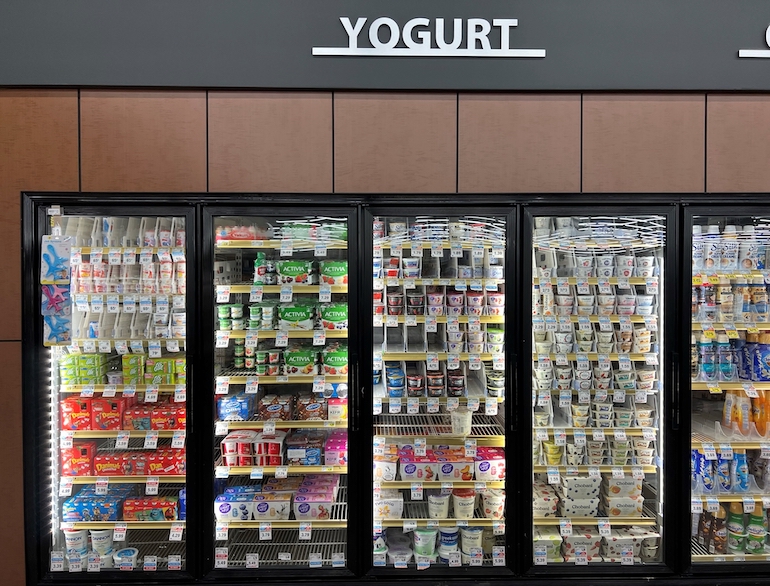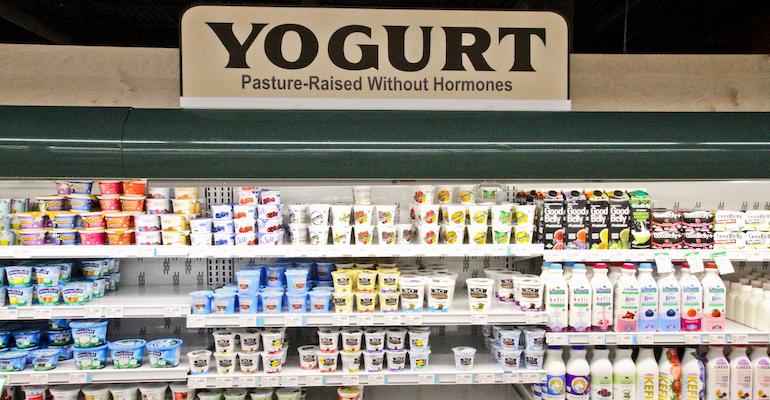Before the COVID-19 pandemic, it seemed the yogurt category was in trouble. Sales in the supermarket slowed, due to an oversaturation of new products and flavors, and consumer demand waned.
Increased at-home snacking and nutritional awareness during the pandemic, however, has changed the landscape for the yogurt category, which is once again on the rise.
In April 2022, yogurt sales at supermarkets totaled $662 million, up 8% year over year, according to the International Dairy Deli Bakery Association. That growth continued an upward trend starting in late 2021.
One of the main reasons is consumers are increasingly aware of the health benefits of yogurt. Yogurt can be high in protein, calcium, vitamins and probiotics. Research has also shown that yogurt can protect against Type 2 diabetes, reduce the risk of heart disease and osteoporosis, and aid in weight management.
“Yogurt offers many health benefits and has growth potential in spaces like high-protein, low-sugar, plant-based and drinkable,” said Erin Rolfes, director of communications for Cincinnati-based The Kroger Co. “Recently, we’ve seen increasing customer focus on health, and gut health in particular. We’ve added to our assortment of zero or low-sugar and keto options, as well as explored plant-based yogurt as alternative milk offerings —oat, pea, etc. — become more mainstream.”
Susan Durfee, director of dairy, frozen, household, baby, pet, health and beauty care, and general merchandise at Williamsville, N.Y.-based Tops Friendly Markets, credits new innovation and flavors with keeping customers interested in yogurt and coming back for more.
“We’ve seen the yogurt category growth driven by new lower-sugar varieties as well as high-protein varieties, bringing more users into the category,” Durfee said.

In recent years, a key challenge for supermarkets has been finding enough shelf space for the slew of different brands, flavors and types of yogurt.
Expanding the options
At the beginning of the pandemic, Kroger saw customers shift toward bigger pack sizes of yogurt, such as tubs or multi-packs.
“We also saw an increased focus on immune health, which drove some customers to explore probiotic-rich foods,” Rolfes said. “Today, customers still favor larger pack sizes, but we’re starting to see a small shift back to single-serve cups.”
Laura Perkins, vice president of purchasing for Lakewood, Col.-based Natural Grocers, noted the yogurt category is still realizing growth and remains a very relevant category at the stores, as are most dairy-based items trending up more than in recent years.
“Plant-based yogurts and drinkables/kefirs had a lot of innovation and new items and were a big part of the growth over the past two years,” Perkins said.
The yogurt market had mostly been single-serve, but that changed starting in March 2020 with the spread of COVID-19, according to Bill Ruschetti, senior category manager for Bashas’ Family of Stores, based in Chandler, Ariz.
“During the pandemic, more people were at home, and not only were they cooking more, but they were also experimenting with and discovering new uses for yogurt,” he explained. “We continue to see an increased variety of yogurt options, including drinkable yogurt and non-dairy yogurts offering an alternative for people who do not consume dairy or animal products or have allergies or intolerances.”
With these trends, Bashas’ has noticed a sales uptick in multi-serve yogurt packaging, and Ruschetti thinks that segment is only going to increase as the calendar turns to summer, when more people will be at home.
Right balance of products
In recent years, one of the top challenges for supermarkets with yogurt has been finding enough shelf space for the slew of different brands, flavor varieties and types. But stores have learned from this, and the majority are limiting what they offer and have on display.
“At Bashas’ Family of Stores, we constantly monitor sales and consumer trends to ensure that our shelf space features items that shoppers want most,” Ruschetti said. “We have found that the best way to market and merchandise yogurt is to segment it by its content and occasion usage — for example, organic, low sugar, no sugar, whole milk/traditional dairy, etc.”
Perkins noted that yogurt, like any product at the store, must turn enough to warrant the shelf placement, with little or no shrink.
“We also look to have a selection for all our customers’ needs and special diets like alternative dairy and plant-based items,” she said. “We’ve found it best to keep like items together, cow-based together, specialty dairy like goat or sheep products together, plant-based together, etc., so customers can find what they need and see the selection available to them.”
Tops stores groups by type — Greek, low-fat, high-protein or children’s flavors — and manufacturer.
“By grouping together, customers can see the wide variety available for them to purchase, giving them the option to buy their current favorite yogurt or try something new, whether it’s for flavor or function,” Durfee said.
At Kroger, yogurt shelf decisions are made by examining the retailer’s consumer shopping data and research, as well as listening to customer feedback on what they would like to see on the shelf, Rolfes said.
“Our goal is always to create an exceptional customer experience, ensuring shoppers can easily find what they’re looking for,” she added.
Looking ahead
Packaging is one area of opportunity for the yogurt category, and Natural Grocers’ Perkins believes some innovation in packaging that is less wasteful than what is currently on the market will emerge in the next few years
Most grocery retailers think the rise in yogurt sales won’t stop anytime soon. Durfee expects the category to continue to see growth throughout 2022.
“The manufacturers in this arena are known for innovation and know that it is needed to keep the consumer engaged in their products,” she said. “By adding new flavors as well as new functional forms, they will continue to meet the consumers changing needs and wants.”





